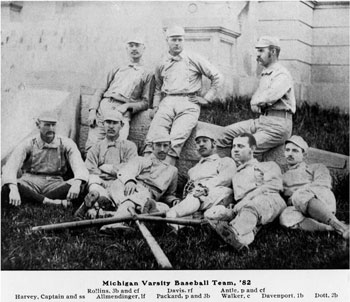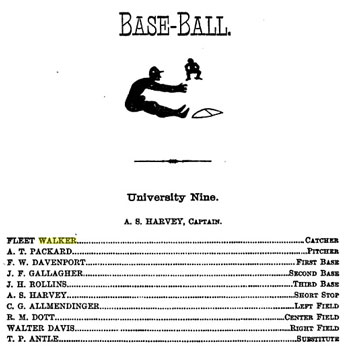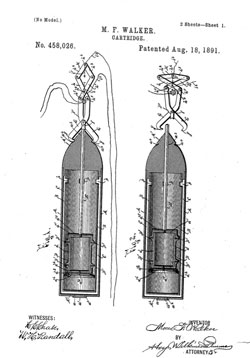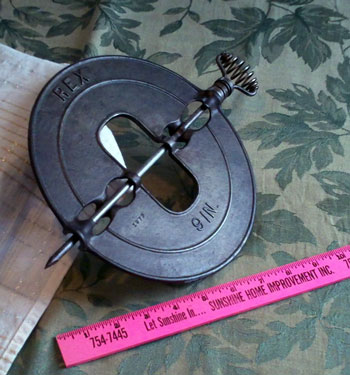In the Archives: Dynamite Baseball Catcher
Editor’s note: Laura Bien’s local history column appears in The Ann Arbor Chronicle usually sometime around last Wednesday of the month. This month’s column draws upon the archives of The Ann Arbor Chronicle’s namesake – a 19th century University of Michigan student newspaper called The Chronicle-Argonaut. In its era, The Chronicle-Argonaut maintained a rivalry with the Michigan Daily – in the form of a “base ball” game. So it’s fitting that Bien’s column this month also highlights University of Michigan baseball from that time period.
He smashed the color barrier in major league baseball. During his lifetime, Congress passed sweeping civil rights legislation. No modern baseball player can wear his team number on a uniform. And unlike Jackie Robinson, he was a University of Michigan alum.
Moses Fleetwood Walker was born Oct. 7, 1856 in Mount Pleasant, Ohio. His parents may have settled there due to the eastern part of the state’s long association with the Underground Railroad.
Moses, or Fleet as he was later called, was the fifth or sixth of seven children born to physicians Moses and Caroline Walker. The 1860 census lists two three-year-olds, Moses and Lizzie. The little girl, possibly Moses’ twin, does not appear in the 1870 census.
Soon after Moses’ birth, the family moved to nearby Steubenville, 40 miles west of Pittsburgh. Their neighbors there worked as bricklayers, dyers, pattern makers, tinners, and laborers. Moses attended an integrated school and at graduation chose Oberlin College, one of the first colleges in the nation to admit black and female students. When Oberlin formed its first baseball team in 1881, Moses joined as a catcher.
It was a tough position to play in that era. The catcher had no body protection or face mask. He didn’t even have a glove, but caught barehanded. In addition, in 1881 the pitcher’s throwing position was not 60 feet and six inches from home plate as it is today, but only 50 feet (and before that 45 feet). Pitchers for a time were even allowed to take a running start. Common catchers’ injuries included broken ribs and fingers, facial injuries, and concussions.
Baseball at University of Michigan
In March of 1882 Moses transferred to the University of Michigan to study law. He was accompanied by his wife of four years, Arabella. Moses joined the university’s baseball team, the first varsity sport to be organized on campus. UM baseball operated without a coach from its inception in 1865 until 1890. The sport also operated without oversight by or funds from an as-yet-nonexistent Athletics Department; the first athletics director, Charles Baird, wasn’t installed until 1898. The team had to pay for its own equipment and travel with money begged from fellow students – receipts were often meager.
Financial challenges were plain in 1882 when the UM team planned to play a distant rival. “A more than sufficient sum of money had been pledged for the use of the nine [team members],” wrote the June 24 issue of the UM student paper The Chronicle, “and we supposed that at least $125 could be raised . . . [w]hat was the surprise and disgust of the committee when it was found that the largest amount that could be raised was about $35.” The disappointed team stayed in Ann Arbor.
But The Chronicle took note of Walker’s performances. “Walker played a brilliant game,” reported one article, “catching without a passed ball, making five runs, and two base hits, besides three singles. The game was witnessed by a large crowd . . .” In the fall of 1882, The Chronicle predicted a strong season: “Dott, Fleet Walker, Packard, Bumps, Hawley, Davis, Allmendinger, are all back and alive to the necessity of keeping up our ball spirit,” reported the Oct. 21, 1882 paper. “Then we have had added to the list Weld[a]y Walker, a magnificent fielder, safe batter, and phenomenal base runner…” Moses’ younger brother had followed him to Michigan and had joined the team.
Other campus papers praised Moses’ performance, and bemoaned the team’s financial struggles. As if anticipating Walker’s incipient departure, the May 5, 1883 Argonaut wrote, “Montgomery as catcher is a worthy successor to Fleet Walker . . . the baseball committee hopes to get through the season without circulating the deadly subscription paper.”
Despite the accolades, by the fall of 1883 Moses had moved on. “Walker of base-ball notoriety is not back this year,” the Oct. 10, 1883 Chronicle informed its readers. Moses had signed with the minor-league Toledo Blue Stockings. The Blue Stockings soon joined the American Association, a two-year-old professional major league formed to compete against the existing National League. Nicknamed the “Beer and Whiskey League” because it served alcohol at games, the American Association was regarded as boorish by its more staid nemesis league. In addition to the Blue Stockings, American Association members included the Washington Senators, the Cincinnati Kelly’s Killers, the Cleveland Spiders, and several surviving teams that include the Cincinnati Red Stockings (Reds), the St. Louis Brown Stockings (Cardinals), and the Pittsburgh Pirates.
By all accounts Moses had played good baseball on campus and earned the respect of his fellow students. He ruined his debut professional performance, however, by flubbing four at-bats and committing four errors. His performance may reflect the possible reception he received from an audience who had never seen a black baseball player. Reactions from his new teammates were mixed, ranging from racism to friendship. As he would throughout his life in a variety of situations, Moses persevered.
During the summer, Moses’ brother Welday also played with the Blue Stockings. Moses was injured during a game, and on Sept. 4, 1884, he played his last game with the team. Though Moses was a pioneer in integrating major league baseball, his Blue Stockings number was never retired – or even recorded, as uniforms of this era generally didn’t have numbers.
UM students had not forgotten Moses, and hopes rekindled that he would return. “[T]here is good reason to believe too that the nine is to be strengthened this year by the return of Fleet Walker,” noted the Oct. 4, 1884 Michigan Argonaut. If nothing else, at least the team finally had some cash. “It is especially gratifying to note that the base ball association stands on a sound financial basis. We are assured that there are fifty dollars in the treasury and no debts outstanding.”
Recovered from his injury, Moses entered the minor leagues and played for teams in Cleveland, Syracuse, and Waterbury, Connecticut. As he worked to advance himself and develop his talent, his ambitions were countered by a worsening national racial climate.
Race Relations
In 1866, when Moses was just 10 years old, Congress had passed the Civil Rights Act. It countered the post-Civil War “Black Codes” that Southern states had enacted to limit the rights of newly free black citizens. The Act was strengthened in 1868 and 1870 by the passage of the 14th and 15th Amendments. Taken together, these actions sought to ensure federal protection of the rights of all male citizens, black and white, to make contracts, have and transfer property, vote, file lawsuits, and enjoy equal protection of the law.
Legal challenges, however, exploited overlooked loopholes and began to erode federal power, returning control to the states in defining and often limiting black citizens’ civil rights. By 1896, the Supreme Court’s Plessy vs. Ferguson decision allowed for a broad definition of “separate but equal” accommodations that served to enable discriminatory “Jim Crow” laws.
Before this tumultuous era culminated in Plessy vs. Ferguson, Moses had been let go from the Syracuse Stars. The minor-league International League banned the hiring of new black players. The American Association and the National League agreed sub rosa to exclude black players. The racial barrier would last until after World War II.
Patents: Dynamite Artillery Shells, Movie Projectors
Moses returned to Ohio and purchased a hotel in Steubenville and a theater for showing films and hosting live events in nearby Cadiz. He worked as a postal clerk, and at one point was accused of embezzling money. Moses managed his properties and with his younger brother published a short-lived newspaper. Arabella died in 1895, leaving three children: Cleatho, Thomas, and George. Three years after Arabella’s death, Moses married Ednah Jane Mason.
Before he lost his first wife, Moses filed for and received the first of his four patents. In 1891 he patented a refinement for a dynamite-loaded artillery shell.
Dynamite guns were a makeshift late-19th-century transitional technology. For most of the 19th century, black powder was the only explosive substance available. When dynamite was patented in 1867, it offered far more destructive power. Inventors scrambled to adapt this technology for military use.
One slight problem with this plan was that dynamite’s explosive force is activated not with a fiery fuse, but with percussion. The shock wave of the firing gun could explode the dynamite-loaded shell while it was still in the gun barrel. Moses designed an artillery shell that contained a suspended piston filled with dynamite. The piston was cushioned by air as the shell was fired from the barrel, to explode on impact with the target. Theodore Roosevelt experimented with dynamite guns; he and his Rough Riders found the machinery too fussy. Superior technology soon made these ingenious yet terrifying armaments obsolete.
Moses had other, less destructive ideas to patent. In 1918, he filed three patents for improvements to movie projectors. His experience with his theater’s film projectors had shown him shortcomings in projector technology. He was granted patents on projector improvements that made it easier to secure film to its metal reel and to tell when one roll of film was near its end.
Moses commissioned a metal-stamping company to make his improved reels, but never turned his creation into a business.
Thoughts on Race
Moses did, however, turn his reflections on race relations into a 47-page 1908 book: “Our Home Colony, a Treatise on the Past, Present, and Future of the Negro Race in America.” His book concluded that the white and black races cannot live harmoniously in the United States. Black Americans, he advised, should shun the de facto American caste system and establish a new settlement in Africa.
“What Negro parent,” wrote Walker in his treatise, “can have the audacity to hold up before his beloved son the possibility of him ever becoming President of the United States?”
Moses’ wife Ednah died in 1920. Two years later he retired. Moses passed away on May 11, 1924.
His still-extant hometown paper, the Steubenville Herald-Star, gave him a lengthy obituary and placed his listing first. The obituary highlighted his career in baseball, detailed his varied occupations thereafter, and expressed community respect. It concluded, “He was a very interesting man to meet in conversation and he had many friends here who will regret to hear of his death.”
Moses Fleetwood Walker is buried in Steubenville’s Union Cemetery.
Mystery Artifact
The mystery artifact from the last column is a collection of objects that may be viewed in the current iteration of the Yankee Air Museum. Within the current exhibit hall, there’s a display case that contains sample soldiers’ field rations from several wars. The collection pictured here represents field rations for WWII soldiers, or, “K rations.”
Jim Rees and Cosmonican guessed correctly; congratulations!
Today for your consideration is a rather large Mystery Artifact that’s appropriate for the season.
It’s heavy and a little wobbly when it’s set on a table. It’s in quite nice condition, though, with no evident chips or scratches. What might this odd thing be? Take your guess and good luck!
Laura Bien is the author of “Hidden Ypsilanti” and “Tales from the Ypsilanti Archives.” Contact Laura at ypsidixit@gmail.com.
The Chronicle relies in part on regular voluntary subscriptions to help remind readers of those who’ve been forgotten. If you’re already supporting The Chronicle, please encourage your friends, neighbors and coworkers to do the same. Click this link for details: Subscribe to The Chronicle.








Oberlin College claims not to be “among the first to admit blacks and women”, but to be THE first.
John Floyd, Class of 1980
John: Thank you for that note. I saw that claim made by Oberlin while doing research but it seems to me to be one that is difficult to prove absolutely without a careful survey of every extant university of the era. This hesitation on my part in no way detracts from Oberlin’s honorable policy of inclusion in an era when that was uncommon.
Jim Rees deserves the honor, not me, for the last item; I had it pegged to the post-war era because of the iodine bottle, and he proved me wrong. The fact that it was a survival kit was obvious to anyone.
I do know the purpose of this present item. Since there are no other entries, I won’t be a killjoy, and keep my opinions to myself until there is some other feedback. If no one guesses right in a month, I may pop back in.
Thank you Cosmonicon; the guess you sent via email is correct! Let’s see if anyone else can peg this item.
Laura, I too know for sure what this is and will join Cosmonicon and hold my reply. I am interested to see what people might guess. Of course if did not know what it was, I would guess that it was the ‘world’s most difficult to throw’ top.
I also know what the item is and will hold off for a while and not put a damper on the guessing game.
It looks like this month’s guesses are carefully concealed knowing comments from those who know. Any chance we can smoke out a real answer?
I would like to take the heat off of the silliness and puns here, and congratulate Laura on another fine article on our lost history. The Mystery Object is like the toy in the cereal box, but the story is what draws me in. Thanks Laura, and thanks to the Observer for publishing these wonderful memories of our past.
Mose’s Walker story is fascinating. There must be many more out there.
Thanks for a fascinating article. What appears to be a pretty good biography of Walker was published in 1995 by a professor of American Studies and sports studies: [link]
If anyone wants to see Moses Walker’s patents they can be found here:
[link]
[link]
[link]
[link]
ABC: I like your guess. Turns out it’s quite nicely balanced on its axis, so who knows; it might work! I’ll put your idea on the back burner till next month.
Ray: That is kind of you; after all, there are a range of possibilites.
Philip: Sounds like you too have warmed to the challenge; now we’re cooking with gas!
Cosmonican: Thank you for your kind comment and for reading!
Paul: I had that book recommended to me when I was communicating with a librarian in Steubenville. I read part of it–it’s written in an engaging, sometimes poetic manner that shows the writer’s passion for the subject. It’s a great recommendation of yours of a very worthwhile book. Thank you!